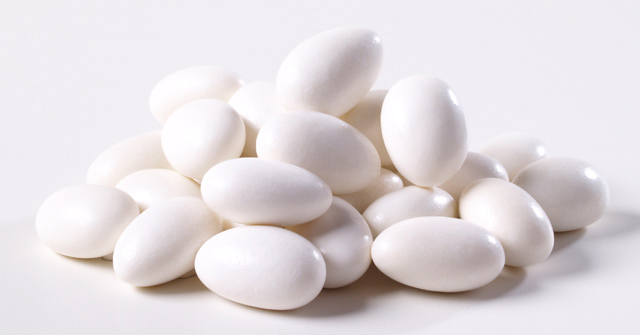History of Jordan Almonds
by Jon Prince
White for weddings, Silver for twenty-fifth anniversaries, Sky-Blue or Pink for christenings, Red for graduations, Green for engagements... smooth, textured, spherical, oval, teardrop, heart-shaped... with centers of almonds, hazelnuts, anise seeds, cinnamon sticks, rosolio (a sweet old-fashioned liquor made of Tangerines), coffee beans, peanuts, pistachios, marzipan, chocolate... in party favors, flower arrangements, fruits baskets and other constructions of the confectioner's art and imagination. These are just a few of the myriad colors, tastes, and shapes of Italian confetti, also known in the "new world" as Jordan Almonds, which are those little sugar-coated candies present at every important occasion in Italian life.
In their most classic form, they are exactly the candies known as sugared almonds, "Jordan Almonds" or dragees. The generic name "confetti" has nothing to do with the French and English word "confetti", bits of colored paper, translated into Italian as "coriandoli".
For the origin of confeti, we must look back to the ancient Romans, who celebrated births and marriages with the distant ancestors of today's confetti. But until the Renaissance, they - and other sweets - were made with honey. The introduction of sugarcane into European kitchens in the XVth century marked the beginning of the modern era for confeti. In the Renaissance, as in antiquity, confetti was not just for ceremonial use. They were real sweetmeats made of candied fruits, or, as we learn from a manuscript of 1504, with almonds, dried fruits, aromatic seeds, hazelnuts, pine nuts or cinnamon, covered with a hard coating of sugar. And they were habitually served not only at wedding banquets but also at many important meals.
We find the first literary attestation of confetti in Boccaccio's Decameron in the 1350s. The earliest testimonies of the high status and near-ritual use of confetti come from the late middle age and Renaissance. In 1487, according to chronicles of the period, more than two hundred and sixty pounds of confetti were consumed at the banquet held the day after the wedding of Lucrezia Borgi and Alfonso D'Este. Son of Ercole I, Duke of Ferrara.
The use of confetti really began to spread through Italy during the late XVIIIth and early XIXth centuries, along with the first "modern" confetti factories appearing in the Abruzzo region, which has become the famous confetti capital for three centuries: in 1783 it became the acknowledged capital of confetti thanks to the skill of a single family which manufactures confetti according to a simple recipe that has remained unchanged.
Although our Jordan Almonds are not made in Italy, we carry a vast array in different sizes and packages that are ideal for any celebratory event.


